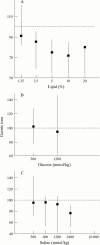Evidence for a lipid specific effect in nutrient induced human proximal gastric relaxation
- PMID: 10189852
- PMCID: PMC1727207
- DOI: 10.1136/gut.43.2.248
Evidence for a lipid specific effect in nutrient induced human proximal gastric relaxation
Abstract
Background/aim: The presence of lipid in the upper gut is able to modify gastrointestinal motor performance, but its influence on the relaxation of the human stomach, which is known to modify gastric emptying, remains incompletely understood. The relaxation of the proximal stomach in response to various lipid concentrations was therefore studied in healthy volunteers. Since the observed effects could be mediated through osmolality or energy sensitive pathways, the effects of equicaloric and equiosmolar non-lipid solutions were also determined.
Methods: The tone of the proximal stomach was measured during stepwise inflation of a non-compliant bag sited in the proximal stomach, both before and after a test meal was delivered intragastrically. Iso-osmolar lipid emulsions were diluted in iso-osmolar saline at concentrations of 1.25, 2.5, 5, 10, and 20%. NaCl solutions at osmolalities of 300, 600, 1200 and 2400 mmol/kg and glucose solutions of 836 and 3344 kJ/l were also given.
Results: All lipid meals of 2.5% or greater concentration induced a reduction in gastric tone in a non-dose-dependent manner, responses to 5% lipid (median (range) 74 (62-92)%) being similar to those to 20% lipid (80 (55-83)%; p > 0.05). No relaxation was elicited by isocaloric glucose. NaCl only consistently caused relaxation at 2400 mmol/kg.
Conclusion: Lipid meals reduce human proximal gastric tone by a lipid specific mechanism, independently of their energy content or osmolality.
Figures


Similar articles
-
Effect of cholecystokinin-A receptor blockade on lipid-induced gastric relaxation in humans.Am J Physiol. 1997 Jul;273(1 Pt 1):G118-23. doi: 10.1152/ajpgi.1997.273.1.G118. Am J Physiol. 1997. PMID: 9252517 Clinical Trial.
-
Relaxation responses of the human proximal stomach to distension during fasting and after food.Am J Physiol. 1994 Aug;267(2 Pt 1):G166-72. doi: 10.1152/ajpgi.1994.267.2.G166. Am J Physiol. 1994. PMID: 8074216
-
Intestinal control of gastric tone.Am J Physiol. 1985 Oct;249(4 Pt 1):G501-9. doi: 10.1152/ajpgi.1985.249.4.G501. Am J Physiol. 1985. PMID: 4050999
-
Cholecystokinin pathways modulate sensations induced by gastric distension in humans.Am J Physiol Gastrointest Liver Physiol. 2004 Jul;287(1):G72-9. doi: 10.1152/ajpgi.00351.2003. Epub 2004 Feb 5. Am J Physiol Gastrointest Liver Physiol. 2004. PMID: 14764444 Clinical Trial.
-
[Use of an electronic barostat for measurement of motor response of the proximal stomach to feeding and different nervous stimuli in man].Gastroenterol Clin Biol. 1993;17(5):321-8. Gastroenterol Clin Biol. 1993. PMID: 8349065 French.
Cited by
-
Appearance of double peaks in plasma concentration-time profile after oral administration depends on gastric emptying profile and weight function.Pharm Res. 2008 Apr;25(4):886-95. doi: 10.1007/s11095-007-9469-z. Epub 2007 Oct 23. Pharm Res. 2008. PMID: 17955185
-
Postprandial glycaemic and insulinaemic responses in adults after consumption of dairy desserts and pound cakes containing short-chain fructo-oligosaccharides used to replace sugars.J Nutr Sci. 2015 Oct 12;4:e34. doi: 10.1017/jns.2015.22. eCollection 2015. J Nutr Sci. 2015. PMID: 26495125 Free PMC article.
-
Principles of applied neurogastroenterology: physiology/motility-sensation.Gut. 1999 Sep;45 Suppl 2(Suppl 2):II17-24. doi: 10.1136/gut.45.2008.ii17. Gut. 1999. PMID: 10457040 Free PMC article. Review.
References
Publication types
MeSH terms
Substances
LinkOut - more resources
Full Text Sources
